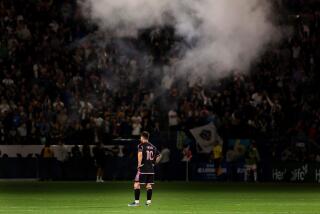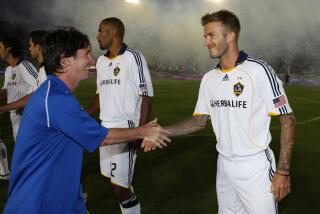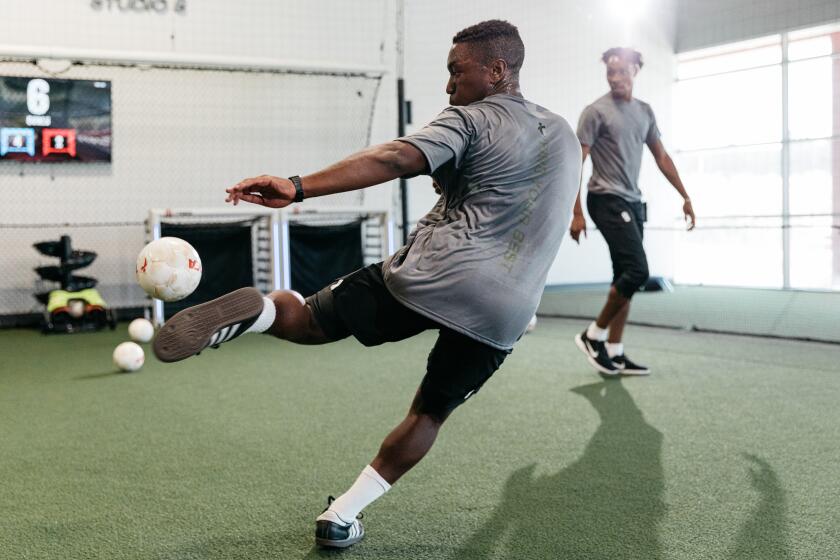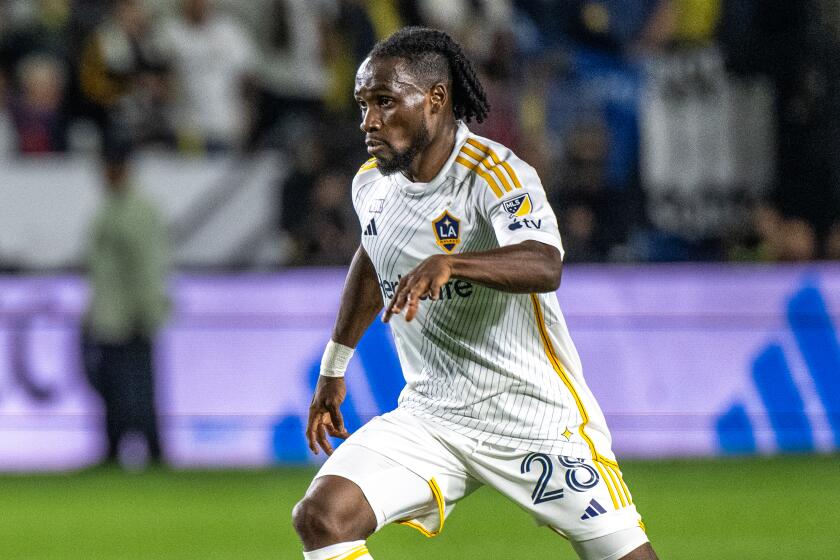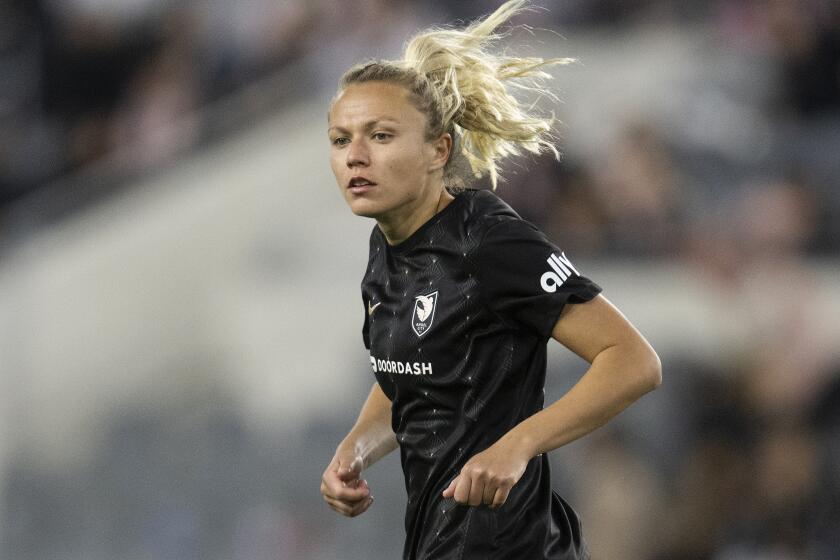FC Barcelona’s youth academy searches for soccer’s next Messi
When Lionel Messi moved from Argentina to Spain, one of his first stops was an 18th Century country cottage across from Barcelona’s famed stadium.
Known as La Masia, Catalan for “the farmhouse,” it housed one of the top soccer academies in the world, a finishing school that had produced Barcelona stars such as Xavi Hernandez, Carles Puyol, Pep Guardiola, Andres Iniesta and Guillermo Amor.
Messi was barely a teenager, 13, when he passed through its iron gates for the first time. Three years later, when he made his first-team debut in 2004, the club’s fortunes improved dramatically.
In the five previous seasons, Barcelona hadn’t won a league or domestic title and hadn’t advanced past the semifinals of any competition outside Spain. In the 11 seasons after, no club in Europe won more often: seven league titles, nine domestic cups, four Champions League titles and three FIFA Club World Cups.
In 2010, Messi, Iniesta and Xavi were finalists for the Ballon d’Or, the only time the same youth academy has produced each of the finalists for world player of the year. Two years later, Barcelona won a La Liga game using a lineup comprised wholly of La Masia products.
On Sunday, Barcelona will finish off its fourth La Liga title in five years, and while the club remains a perennial contender in Europe’s Champions League, the academy pipeline that fueled years of winning has gone dry.
Sergi Roberto and Rafinha are the only academy graduates on the roster who made their La Liga debuts since 2011 and have appeared in at least 20 league games. Puyol has retired, Iniesta left Barcelona for Japan last year and Xavi, who spent his final four seasons in Qatar, is retiring this month.
Messi, Gerard Pique, Sergio Busquets and Jordi Alba, all La Masia graduates, remain on the first-team roster, but Alba, the youngest of the four, turned 30 this season.
“The La Masia model is not what it used to be. And it’s a pity,” said Laurent Colette, a former Barcelona executive and now a member of the executive board for French club Marseille. “The model is not so clear now. They have to rebuild a little bit in order to have a better identity.”
Earlier this month, Barcelona blew a 3-0 lead to Liverpool in the second leg of the Champions League semifinal — the second consecutive year Barca gave away a three-goal lead and lost in the knockout stage and the ninth time in 10 seasons the Catalan club has failed to reach the final of a tournament it once dominated.
A poor return for the $4.5 million the club spends on the academy each year.
“Bringing talent is very difficult,” Barcelona president Josep Maria Bartomeu said. “We don’t see any [other] Leo Messis in the world.”
::
It has been eight years since the academy left the farmhouse and moved five miles south, to a sprawling complex inside the walls of the Joan Gamper Sports City in a gentrifying Barcelona suburb.
Developmental academies are part of every major soccer club; all but one of the 24 Major League Soccer teams have one youth team. What sets La Masia apart is the type of soccer that’s taught, an attractive if complicated style of play that results in, if not always victories, “football that is nice for your eyes,” said Bartomeu, the club’s president since 2014.
In that, there is no compromise. Zlatan Ibrahimovic scored 21 goals his first season in Barcelona but didn’t fit the system, so he returned to Italy.
Barcelona’s signature approach is attacking, possession-based and built around short, quick passes. Players are taught to not touch the ball more than twice before passing to a teammate. Executed correctly, it is breathtaking to watch.
One night this winter, the academy’s nine fields were filled with 16 teams of boys and four teams of girls, from ages 7 to 18, all practicing the same, complex ball-control skills.
About 55 soccer players reside at La Masia, all on scholarship. Another 20 residents participate in other sports such as basketball and handball. The youths sleep two to a room in spartan dorms a couple of dozen paces from the cafeteria and a few dozen more from the study halls, audiovisual theater, massage room and gym.
Each weekday between September and June unfolds much the same way, beginning with a 6:30 a.m. wake-up call, followed by breakfast and a 7:30 bus to a nearby public school. When classes end in the early afternoon, the players are bused back to La Masia for lunch, study time with tutors and training sessions from 7 to 9 p.m. Another 240 boys who live within an hour’s drive take club-provided taxis or other transportation to and from the complex for the evening training.
There’s a mind-numbing rigidity to the fast-paced drills: receive the ball, control it, pass it, then sprint up the field and do it again.
David Sanchez, one of 40 coaches at La Masia, paused the sequence and called over to a 7-year-old too small for his sagging blue-and-red Barcelona jersey.
“What do we practice?” Sanchez asked in Catalan.
“Maximum intensity. One vs. one,” the boy responded quickly.
“What happens when we lose the ball,” Sanchez asked.
“We win it back,” the boy answered.
The repetition required to form the skills to play the Barca style is one reason the club starts with players so young.
“If we pick up players when they are 16, 17 they have less time to learn this process,” said Denis Silva, a coach in his ninth season. “Barca is one of the few [clubs] that have had the same philosophy for years and years and years. That’s the most important thing here. There can [be] new players, new coaches, new bosses.
“The style, you cannot touch.”
::
Barcelona’s academy was born in 1979, but it was 10 years before it assumed an identity or enjoyed much success. The transformation can be credited to Johan Cruyff, a former Dutch World Cup star and Barcelona great.
In his playing days, Cruyff had been the catalyst of a revolutionary, improvisational style known as Total Football, which relied on speed and precision over devotion to formations and rigidly defined positions.
When he returned to Barcelona as coach in 1988, Cruyff found the club and academy filled mainly with brutish, physical players, not the technical, cerebral types his style required.
La Masia had to be overhauled, and Cruyff began by discarding a rule that said only players sure to grow to 5 feet 9 or taller could be admitted. That immediately opened the door for the diminutive Pep Guardiola, who eventually sprouted to 5-11 and, more importantly, became one of the best midfielders in club history. The change also opened the door for Messi, a five-time world player of the year, and Iniesta, one of Spain’s most decorated players. Both topped out at 5-7.
Cruyff had come through the famed Ajax academy in Amsterdam, which taught a fluid, fast, free-flowing style upon which many of the Barcelona precepts were modeled. Cruyff mandated that every team at La Masia play that way, attacking relentlessly from a then-uncommon 3-4-3 formation.
In those early years, academy coaches remember Cruyff asking how their team had played — never whether they won. That philosophy continues today.
“As a coach you don’t think about winning,” Silva said. “The winning comes because you respect the style and you make your team understand and enjoy playing like this.”
Two years after Cruyff remade La Masia, a Barcelona team led by academy graduates Albert Ferrer and Guillermo Amor started a run that produced four straight league titles. A year later, Cruyff added Guardiola and Barcelona won its first European Cup.
“The player who has passed through La Masia has something different to the rest,” said Guardiola, who has used the Barcelona style to win league and continental crowns as a coach in Spain, Germany and England. “It’s a plus that only comes from having competed in a Barcelona shirt from the time you were a child.”
Each year, the club holds tryouts for boys 6 to 11. Thousands apply for the academy, and scouts are in charge of determining the cream of the crop who are invited to train in residence.
Nearly all of the boys are Spanish, but it hasn’t always been that way.
For years FIFA, soccer’s governing body, has had a rule prohibiting players from registering with a club outside their home country until they are 18. But only in the last five years has the rule been strictly enforced.
“That is a handicap,” said Bartomeu, adding that the rule is especially tough on players from poor countries in Africa and Latin America who had been eligible to study and train at La Masia on scholarship.
“If your kid plays tennis, you can send him wherever you want in the world. There is no age limitation. If your kid plays golf or is a good handball player or basketball player, you can send him wherever you want. Only FIFA and soccer is limited to the ages.”
There are exceptions for those older than 16 who hold a passport from a European Union country, and for players whose family moved to Spain for reasons other than soccer.
There are two Americans in Barcelona’s academy: Konrad de la Fuente, a 17-year-old B team player from Miami whose father is a Haitian diplomat; and 13-year-old Adrian Simons, who enrolled last year after his family came to Barcelona for work.
Sign up for our weekly soccer newsletter »
With its ability to host international players limited, Barcelona has taken its training abroad. It has 49 academies and more than 180 camps in 56 countries, introducing more than 45,000 boys and girls to its playing style.
Among the most elite of its facilities is the residential academy opened two years ago in Casa Grande, Ariz., where scholarship players between 12 and 19 take part in a program similar to the one in Spain. Galaxy defender Julian Araujo, who made his MLS debut this spring at 17, is among the graduates of the Arizona academy.
Silva, who coached at the Arizona academy for three months, said there is one main difference between the American and Spanish schools: “There, the studies are more important than the sports,” he said of the U.S. academy. “When they have any problem in the school or bad evaluations, they punish the player with no training or no playing.
“Here, it is not possible. Here, as a coach, I try to help them make the first team. I never put the education, meaning their studies, before their work.”
Who knows, maybe the next Messi is out there somewhere but hasn’t been identified yet. Bartomeu remains hopeful.
“It’s new energy,” he said of the academy youngsters. “New hopes, new goals.”
kevin.baxter@latimes.com | Twitter: @kbaxter11


